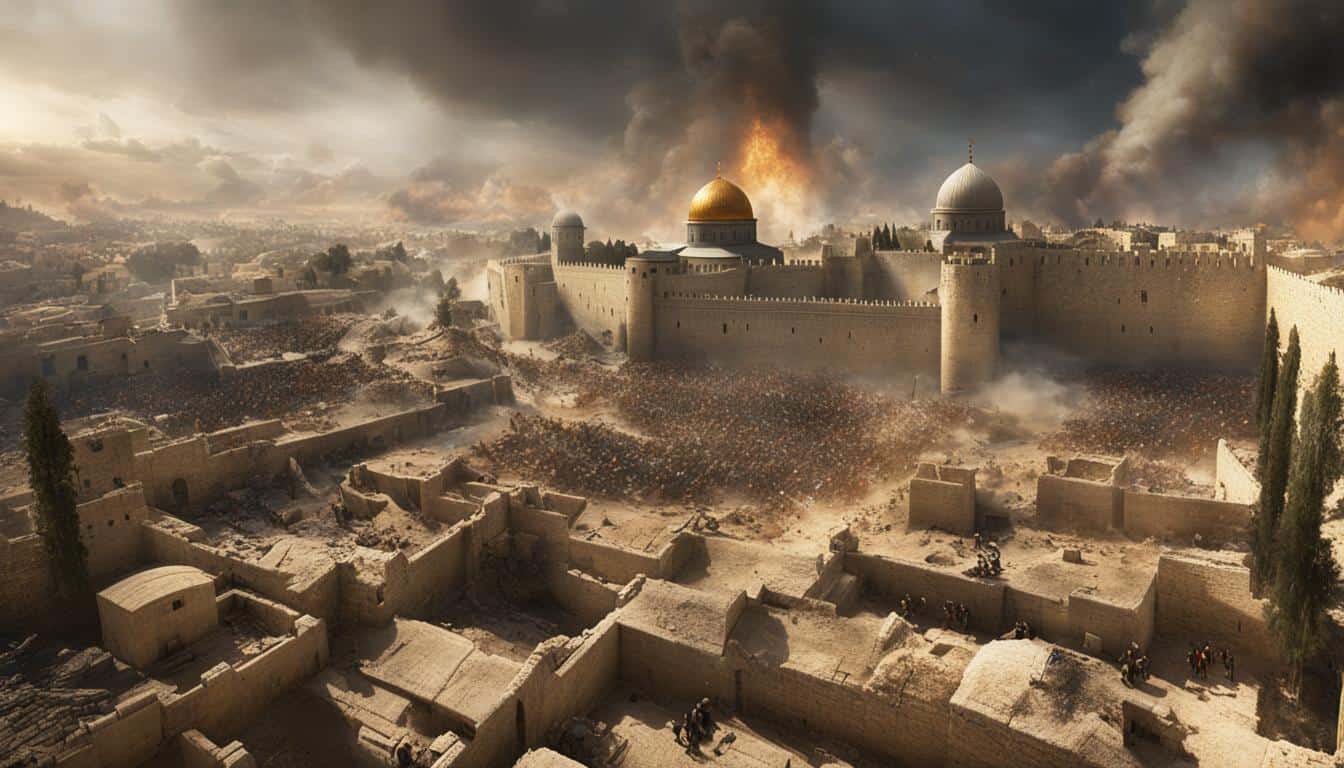Table of Contents
Jerusalem has a long history marked by wars and rulers. Ever wondered about its enemies and their effects on the city?
We’ll explore the key battles and invasions that shaped Jerusalem. From the Assyrians to the Romans, each left a lasting impact. These events show Jerusalem’s remarkable ability to endure.
Let’s dive into the tales of Zion’s foes. We’ll learn how they shaped the city’s spirit. Get ready for a journey of discovery. It will challenge what we think we know.
The Siege of Jerusalem in 701 BC: A Prelude to Redemption
Jerusalem has seen many conflicts, but the siege in 701 BC stands out. This event was crucial. It led to a special kind of hope found in Christ.
The siege brought hard times to Jerusalem and its people. The Assyrian army, under King Sennacherib, sought to conquer the land. The city was trapped, without supplies, facing fear and hopelessness.
Yet, in this tough time, Isaiah gave hope with his prophecy. According to Isaiah 37:33-35, deliverance was coming.
“Therefore thus saith the Lord concerning the king of Assyria, He shall not come into this city, nor shoot an arrow there, nor come before it with shield, nor cast a bank against it. By the way that he came, by the same shall he return, and shall not come into this city, saith the Lord. For I will defend this city to save it for mine own sake, and for my servant David’s sake.”
This prophecy was a beacon of light. It promised redemption and God’s protection. The struggle foretold the great deliverance by Christ.
Jesus was the Messiah Isaiah spoke of. His death on the cross brought salvation to all believers. This siege’s prediction pointed to Christ’s greater rescue.
The siege reminds us of God’s plan. It shows the lasting promise of hope, even in the darkest times.
Through Isaiah, we learn the siege was not just a period of pain. It was the start of ultimate salvation through Christ. This confirms God’s love and his dedication to saving his people.
| Key Points | Implications |
|---|---|
| The Siege of Jerusalem in 701 BC was a pivotal event in the city’s history. | It marked a turning point and served as a prelude to the redemption found in Christ. |
| Isaiah’s prophecy during the siege offered hope and assurance to the people of Jerusalem. | It foreshadowed the ultimate deliverance that would come through the life, death, and resurrection of Jesus. |
| The siege highlights the profound link between historical events and God’s redemptive plan. | It emphasizes the unchanging nature of God’s promises and the hope that can be found in the darkest of times. |
Nebuchadnezzar’s Conquest: Reflections of Hope Amidst Despair
In 2 Kings 25, the city of Jerusalem falls to Nebuchadnezzar of Babylon. The walls are breached and the holy temple destroyed. This marks a time of great despair for the Israelites who are then exiled. Yet, in this dark time, glimmers of hope point towards redemption through Christ’s suffering.
Jerusalem’s fall hints at the suffering Christ would face for humanity’s salvation. Like the Israelites paid for their mistakes, Jesus took on our sins on the cross. His sacrifice gives us a chance at being restored and reconciled with God.
“Surely he hath borne our griefs, and carried our sorrows: yet we did esteem him stricken, smitten of God, and afflicted. But he was wounded for our transgressions, he was bruised for our iniquities: the chastisement of our peace was upon him; and with his stripes we are healed.” – Isaiah 53:4-5 (KJV)
After its fall, Jerusalem saw a symbolic rebirth, much like Jesus’ victory over death. This tragedy reminded us that God’s true dwelling is not in a building, but in Jesus Christ Himself.
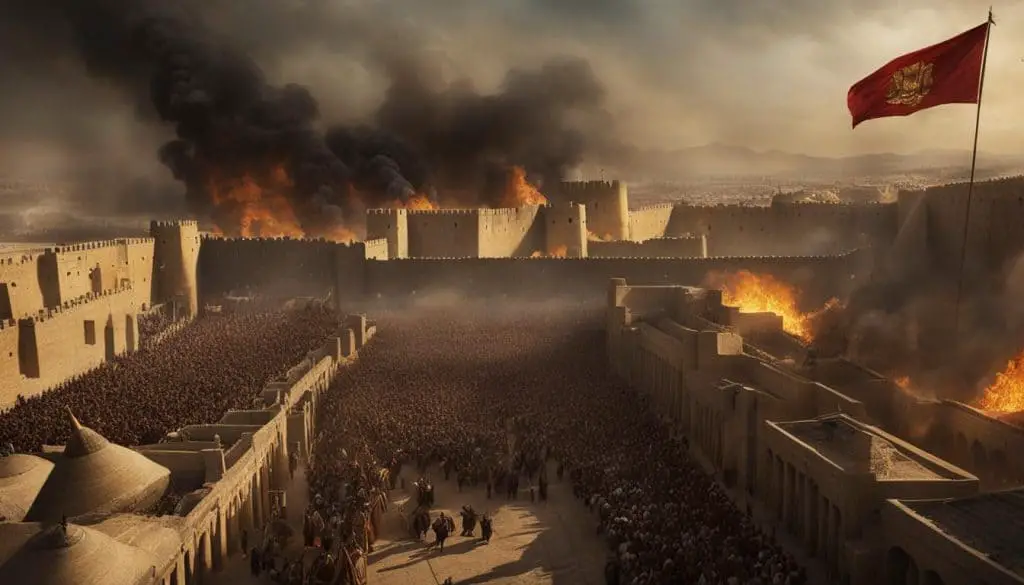
The end of Nebuchadnezzar’s rule brings glimpses of Christ’s suffering, resurrection, and restoration. Let’s hold onto the hope these stories bring and cherish the redemption through Jesus’ love.
The Maccabean Revolt: A Fight for Holiness
The story of the Maccabean Revolt in 1 Maccabees 4:36-59 shows the Maccabees’ strong will. They fought hard for what was sacred. Under Judah Maccabee’s lead, this revolt was against the temple’s violation in Jerusalem by Seleucid ruler Antiochus IV Epiphanes.
Their love for God drove them. They aimed to make the temple sacred again. They stood strong, not letting their faith waver. They bravely faced those trying to erase their beliefs.
“Then Judas and his brethren said, Behold, our enemies are discomfited: let us go up to cleanse and dedicate the sanctuary.”
The Maccabees were deeply devoted, just like Christ was to his Father’s house. Jesus showed this when he overturned tables in the temple. He, like the Maccabees, knew the temple must be cleansed.
The revolt is similar to Jesus’ spiritual fights. While the Maccabees faced real enemies, Jesus fought against evil, sin, and death. His death on the cross was a victory, offering salvation to believers.
Thinking about the Maccabean Revolt can inspire us. Their passion and dedication teach us to stand strong in our faith. It encourages us to uphold what is right and aim for holiness.
Key Takeaways:
- The Maccabean Revolt, as depicted in 1 Maccabees 4:36-59, fought for holiness after the temple’s desecration in Jerusalem.
- The Maccabees’ efforts to protect the temple’s sanctity echo Jesus’ respect for his Father’s house.
- The story shows the importance of keeping faith and the quest for holiness, similar to Jesus’ spiritual contests.
| Maccabean Revolt | Passion of Christ |
|---|---|
| Zeal for holiness | Reverence for the Father’s house |
| Fight against oppression | Spiritual battle against evil |
| Preservation of religious identity | Securing salvation for all |
Herod’s Temple: A Shadow of the True Temple to Come
Herod’s Temple was built during King Herod’s reign in the 1st century. It is significant for both history and spirituality. After the Babylonian exile, it was reconstructed to honor God and provide a place for meeting Him. Yet, it holds deeper meaning within its walls.
Jesus saw the temple as a symbol of His body during His time on earth. In John 2:19-21, He stated, “Destroy this temple, and in three days I will raise it up… But he spoke of the temple of his body.” This hinted at Jesus’ resurrection, showcasing Him as the true way to connect with God.
Jesus’ resurrection changed how we see the temple’s importance. It’s not just a building, but a spiritual reality represented by Jesus Himself.
“For as the body without the spirit is dead, so faith without deeds is dead also.” – James 2:26
The early church realized that Jesus’ resurrection eliminated the need for a physical temple. Believers could directly connect with God through Jesus. The temple was now a preview of a greater reality that was to come.
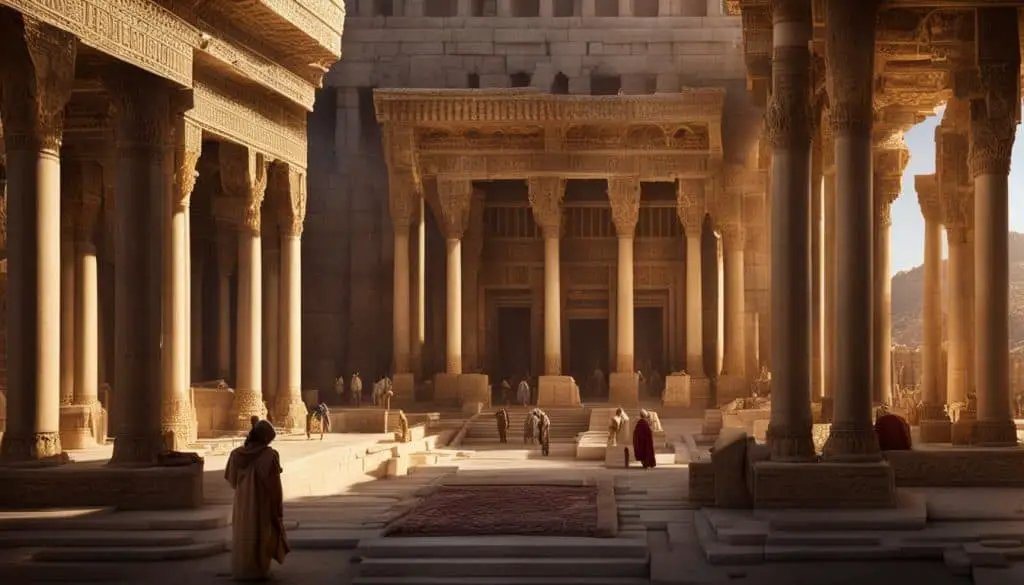
The Temple and Resurrection: A Closer Look
The temple played a vital role in the Old Testament. It was where sacrifices were made for sins. The blood sprinkled on the altar symbolized sin forgiveness and restored God’s relationship with His people.
Similarly, Jesus’ sacrifice and resurrection atoned for human sins. By His blood, we are brought back to God, opening up the path to eternal life.
This link between the temple and resurrection shows Jesus as the ultimate sacrifice. He fulfilled prophecies from the Old Testament. The temple, symbolizing the meeting place with God, led to Jesus, who is the true meeting place with God.
A Comparison of Herod’s Temple and Jesus
| Herod’s Temple | Jesus as the True Temple |
|---|---|
| Physical structure | Living embodiment |
| Meeting place with God | Direct access to God |
| Animal sacrifices for forgiveness | Perfect sacrifice for eternal forgiveness |
| Symbol of God’s presence | God’s presence incarnate |
Reflecting on Herod’s Temple reminds us of Jesus’ resurrection power. His sacrifice grants us God’s presence and forgiveness forever. The temple was just a shadow, pointing us to Jesus, the ultimate connection with God.
The Roman Siege of 70 AD: A Judgment Foretold
Jesus talked about the Roman Siege of 70 AD as divine judgment on Jerusalem. The events leading up to the siege hold deep spiritual meaning. Through Luke 21:20-24, we see Jesus’ prophetic insight, showcasing His role as a prophet.
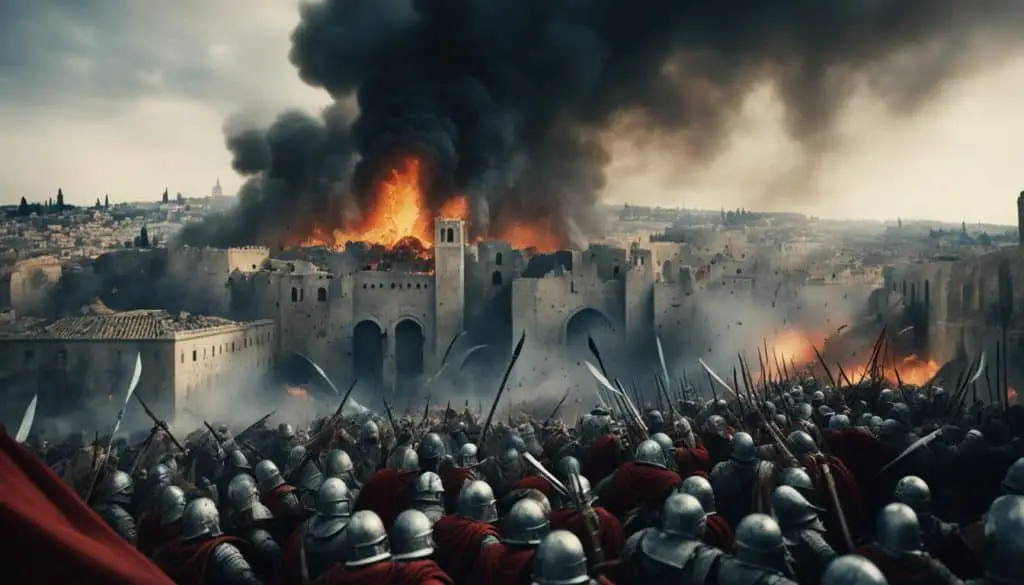
As Roman forces approached Jerusalem, Jesus alerted His disciples about what was coming. He spoke of the city’s forthcoming devastation. This prophecy was fulfilled when the Romans attacked, ending the Jewish revolt.
“But when ye shall see Jerusalem compassed with armies, then know that the desolation thereof is nigh. Then let them which are in Judaea flee to the mountains; and let them which are in the midst of it depart out; and let not them that are in the countries enter thereinto.”
Jesus’ warning was clear. He advised people to escape Jerusalem to avoid the judgment. But many ignored His plea, facing terrible consequences as a result.
The Roman Siege in 70 AD didn’t just destroy Jerusalem. It also taught a harsh spiritual lesson. It showed what happens when God’s warnings are ignored.
The Lessons of Divine Judgment and Mercy
The Roman Siege teaches about God’s judgment and His mercy. It shows that God’s justice is serious, but His mercy offers hope during judgment.
Jesus’ prophecy reminds us that while judgment may be certain for those who turn away from God, His mercy remains for those seeking forgiveness. The fall of Jerusalem marks the importance of repentance. It’s a call to return to God and receive His mercy.
From the Roman Siege of 70 AD, we learn valuable lessons. It’s crucial to listen to prophets’ warnings, embrace God’s mercy, and follow His will. Let’s repent, abandon sinful ways, and find forgiveness in Jesus Christ’s love.
The Byzantine Reconquest: Symbolism of Christian Victory
During the Byzantine Reconquest of Jerusalem, the city underwent a profound transformation. It marked a turning point in its history. The Christianization of Jerusalem under Byzantine rule symbolized Jesus’ victory over sin and the establishment of God’s kingdom on earth.
The Byzantine Empire, with its capital in Constantinople, saw Jerusalem as a crucial Christian site. They worked to reclaim and restore the city. Churches were built and the city was revitalized, reflecting the Byzantines’ effort to make Jerusalem a hub for Christian worship and pilgrimage.
As the Byzantine Reconquest unfolded, the spiritual significance of Jerusalem grew. The city became a testament to Jesus’ victory over sin. The restoration of Christianity in Jerusalem symbolized the triumph of light over darkness.
“The Byzantine Reconquest of Jerusalem renewed hope and purpose for Christians. It was a time of restoration, both physically and spiritually, establishing God’s kingdom in this holy city.” – Anonymous
The Christianization of Jerusalem under Byzantine rule highlighted Jesus’ victory. It reminded us of His teachings and the redemption promised to believers. The restored churches and institutions became centers for worship and learning, strengthening the Christian faith.
The Christianization of Jerusalem: A Proclamation of Jesus’ Victory over Sin
Under Byzantine rule, Jerusalem showcased Jesus’ victory over sin. It became a living example of God’s kingdom. The Byzantines aimed to create a faithful, unified Christian community in Jerusalem. This reflected the divine order Jesus wanted to establish on earth.
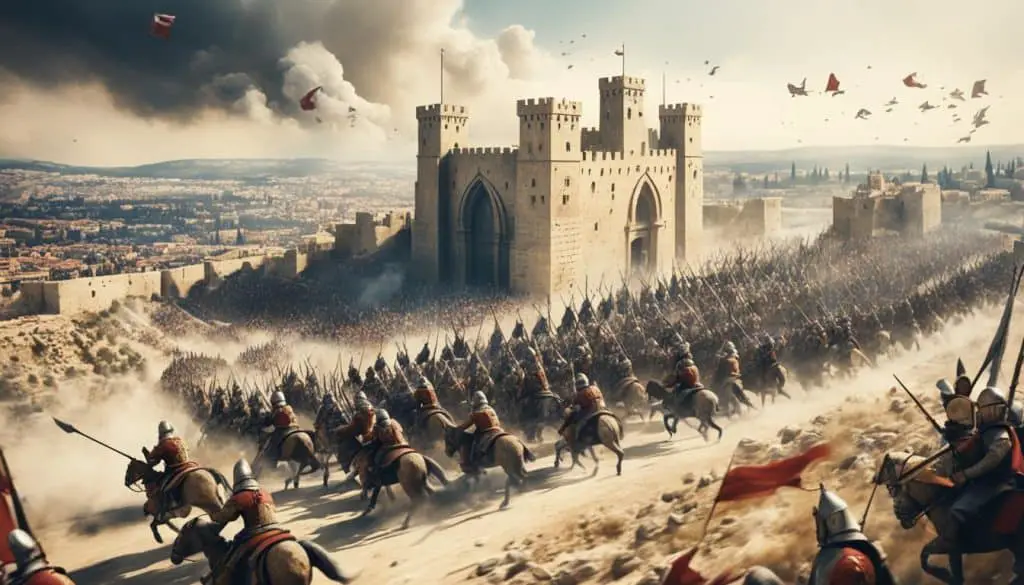
| Symbolisms in the Byzantine Reconquest | Meaning |
|---|---|
| Restored Churches | Symbolic of the restoration of the Christian faith and Jesus’ victory over sin. |
| Christian Pilgrimage Sites | Provided believers a physical connection to Jesus’ life, death, and resurrection. It reinforced the significance of His victory over sin. |
| Religious Institutions | Nurtured spiritual growth and education. It ensured Jesus’ teachings were preserved and spread. |
| Unity among Christians | Reflected the unity of believers under Jesus’ reign and His kingdom’s establishment. |
Through Christianizing Jerusalem, the Byzantine Reconquest did more than rebuild structures. It revived the city’s spiritual essence. It stood as a strong testament to Jesus’ victory over sin and God’s kingdom’s establishment, a victory that keeps inspiring believers today.
The Islamic Conquests: Challenges to the Faith
The Christian community in Jerusalem met big challenges during the Islamic conquests. They came across a new religious and political rule. Their strong faith in Christ showed through despite these hard times.
The Christians in Jerusalem stayed true to their faith in Christ, no matter what. Even when things got tough because of the Islamic conquests, they didn’t give up. Their dedication to Christ was a beacon of hope for everyone.
Despite facing many obstacles, Christians in Jerusalem showed remarkable perseverance. They dealt with persecution, efforts to blend them into the culture, and unfair rules. Yet, they kept worshiping, teaching, and sharing the Gospel, all without losing their focus on Christ.
“Now therefore ye are no more strangers and foreigners, but fellowcitizens with the saints, and of the household of God; And are built upon the foundation of the apostles and prophets, Jesus Christ himself being the chief corner stone.”
– Ephesians 2:19-20 (KJV)
These Christians saw their faith as the most important part of who they were. They knew standing strong, especially when times were tough, honored God. It showed the hope they found in Christ.
Despite everything, the Christians in Jerusalem kept their faith strong. They looked to Jesus’ teachings and how He handled tough times for courage. The challenges they faced helped them grow closer to God and understand His kindness better.
Thinking about the Christian response to the Islamic conquests teaches us about staying strong in our faith. We can learn from those Christians in Jerusalem. Their undying faith in Christ encourages us to keep believing in God’s promises.
“And let us not be weary in well doing: for in due season we shall reap, if we faint not.”
– Galatians 6:9 (KJV)
When we face tough times, we can look back at how others have stayed strong. The Christians in Jerusalem during the Islamic conquests can teach us a lot. Their strength gives us hope and a stronger belief in Christ.

The Crusades: The Quest for the Holy City
During the medieval times, Christians launched military missions called the Crusades. Their goal was to take back Jerusalem and other sacred places from Muslim hands. This tough journey was like the spiritual warfare Jesus fights for our souls. He asks us to join the fight against darkness.
The Crusades showed how faith and war were linked for Christians. They felt they were following Jesus’ call to save the Holy Land. These wars were more than just fights over land. They were battles for their religious beliefs and to keep sacred places safe.
“Our Lord Jesus Christ who sees the hidden things of the heart knows that as far as we seek His honor, service, and love without our corruptions—He is well pleased (Matthew 6:33), and shall, by His wisdom, power, and providence, dispose of all things to our soul’s advantage. When the imperfections of our faith and conditions are known unto Him who hath made them perfect and hath pardoned our transgressions in His blood (Colossians 1:14).”
The Crusaders saw themselves as Christ’s soldiers. They fought for both heavenly glory and spiritual victory. Like Jesus invited His followers to bear their cross and join Him, the Crusaders felt they were doing just that. They believed they were warriors for God’s Kingdom.
The Spiritual Warfare Perspective
The Crusades are a reminder of Jesus’ battle cry, not for war but against evil. It’s a call to resist what blocks our spiritual growth and relationship with God.
Like the Crusaders, we face spiritual challenges too. Our journey of faith is also a battle against sin, temptation, and dark forces. It urges us to stay alert, stand firm, and lean on the Holy Spirit.
“Put on the whole armor of God, that ye may be able to stand against the wiles of the devil. For we wrestle not against flesh and blood, but against principalities, against powers, against the rulers of the darkness of this world, against spiritual wickedness in high places” (Ephesians 6:11-12).
Life’s struggles call us to arm ourselves with Jesus’ spiritual gear. We stand strong through faith, righteousness, and truth. The Crusades show us the eternal fight between good and evil. They highlight the importance of joining the spiritual battle.
Comparison of the Crusades and Spiritual Warfare
| Aspect | The Crusades | Spiritual Warfare |
|---|---|---|
| Motivation | Faith-driven quest to recapture holy sites | Commitment to fight against spiritual darkness |
| Enemy | Muslim control of Jerusalem | Forces of evil and spiritual opposition |
| Weaponry | Swords, shields, and military strategies | Spiritual armor, prayer, and reliance on the Holy Spirit |
| Goal | Physical recapture of Jerusalem | Overcoming sin, growing in faith, and deepening our relationship with God |
The comparison above shows similarities between the Crusades and our spiritual fights. Both are founded on deep faith, acknowledging adversaries, using strategic tools, and aiming for a lofty objective.
Thinking about the Crusades reminds us of Jesus’ invitation to spiritual warfare. Just as the Crusaders aimed for Jerusalem, we strive for spiritual triumph and to let God’s Kingdom reign in us.
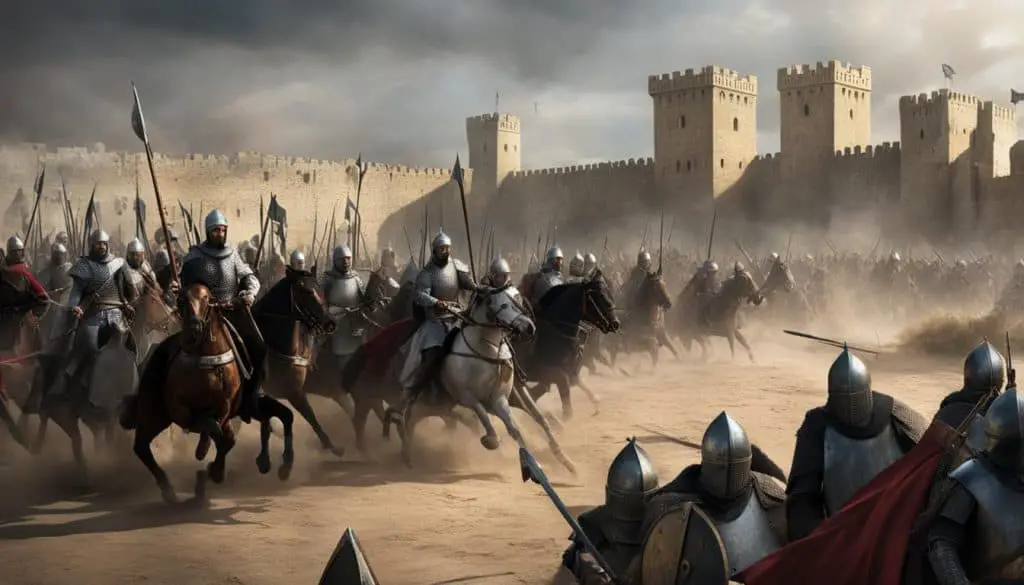
The Ottoman Empire and Jerusalem: A Period of Waiting
The Ottoman Empire was key in Jerusalem’s history, especially during Jesus’ era. This was a time filled with hope for the Messiah’s arrival. People in Jerusalem looked forward to being freed from Ottoman control and the fulfillment of God’s promises.
The Empire, lasting from the 14th to the early 20th century, included Jerusalem. This made the city a hub for trade, culture, and faith. Its diverse people, Jews, Christians, and Muslims, all wished for redemption in their own ways.
A strong connection exists between the Ottoman era and Jesus’ time in their desire for freedom. People under Ottoman rule and Jews under Roman control both longed for liberation. They awaited a Messiah to bring peace and establish God’s realm, though their views on the Messiah differed.
Under Ottoman rule, Jerusalem was ripe with spiritual hope. The city was important to all Abrahamic faiths. Its varied religious groups looked forward to the Messiah, each holding unique expectations and viewpoints.
Many saw Jesus as the awaited Messiah. His teachings, miracles, and kindness stirred hope. The residents of Jerusalem eagerly awaited His coming and God’s promises being met.
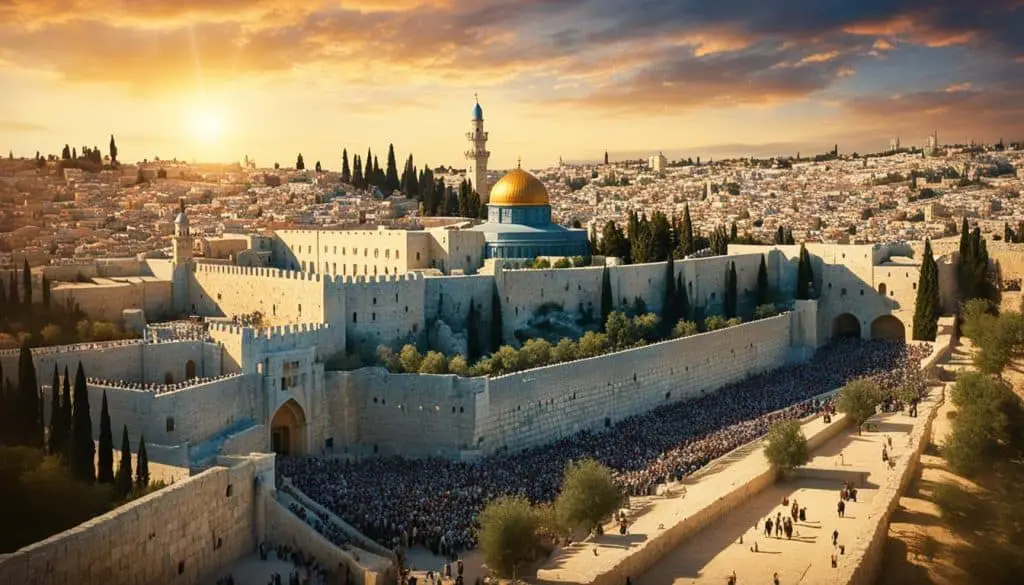
Reflecting on the Ottoman rule and the expectation of Jesus’ time links to our hope for Christ’s second arrival. Like the people back then, we await Jesus’ return, the true Messiah.
Comparing Ottoman Rule and Jesus’ Time
| Ottoman Empire | Jesus’ Time |
|---|---|
| Period of foreign rule and oppression | Period of Roman occupation and oppression |
| Anticipation of deliverance from Ottoman rule | Anticipation of deliverance from Roman occupation |
| Diverse religious communities with their own expectations | Diverse religious communities with their own expectations |
| Sense of spiritual longing and anticipation | Sense of spiritual longing and anticipation |
| Eagerly awaiting liberation and the fulfillment of promises | Eagerly awaiting liberation and the fulfillment of promises |
The wait for freedom from the Ottomans ended with their empire’s fall. Similarly, we trust our wait for Christ’s second coming will be met. Meanwhile, we live in hope and faith, looking forward to God’s promises coming true.
How Did the Leadership in Jerusalem’s Biblical History Impact the Conflicts and Conquests in Jerusalem’s History?
The leadership in Jerusalem’s history played a pivotal role in shaping the conflicts and conquests in the region. From King David to King Solomon and beyond, the decisions and actions of the leadership in Jerusalem’s history influenced the city’s geopolitical landscape and left a lasting impact on its historical trajectory.
Modern Conflicts and the Quest for Peace
When we think about Jerusalem’s long history of struggle, we realize peace is hard to find. In today’s conflicts, we see the need to find Jesus Christ, the Prince of Peace.
Jerusalem has always been a center of tension, politically, religiously, and culturally. It’s a place where different beliefs clash even now. Yet, Jesus’ message gives us hope for peace and togetherness.
Jesus, known as the Prince of Peace, teaches us to seek peace and reconciliation. His lessons are about love, forgiveness, and understanding. They show us how to live in unity and peace, even when it’s tough.
Following Jesus’ steps towards reconciliation helps us heal and come together. By believing in Jesus and working together, we can build understanding and promote peace. In a world looking for peace, let’s follow Jesus towards a hopeful future.

